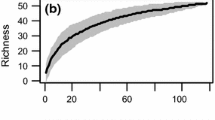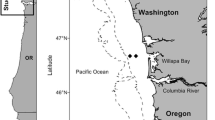Abstract
Within the tropical and subtropical oceans, tuna forage opportunistically on a wide variety of prey. However, little is known about the trophic ecology of the smallest size classes which play an important role in stock assessments and fisheries management. The foraging behavior of yellowfin tuna, Thunnus albacares (23.5–154.0 cm FL), collected from nearshore Fish Aggregating Devices (FADs) around Oahu was studied using stable isotope and stomach contents analyses. Emphasis was placed on small juveniles. Yellowfin tuna changed their diets significantly between 45 and 50 cm forklength (ca. 1.5 kg). Smallest size classes fed on planktonic organisms inhabiting the shallow mixed layer, primarily larval stomatopod and decapod crustaceans, whereas larger tuna fed on teleosts and adult Oplophorus gracilirostris, a vertically migrating mesopelagic species of shrimp. When interpreting the variation in prey δ 15N values, we considered both their relative trophic position and δ 15N values of the nitrogen at the base of the food web. Based on the distinct diet shift of the yellowfin tuna, demonstrated by both isotope and stomach content analyses, we propose a critical mass threshold was reached at about 45 cm FL that enabled sufficient endothermic capability to allow tuna to access prey dwelling in deeper, colder water. These ontogenetic changes in foraging range and commensurate shift in diet of small tunas would affect their vulnerability to fishing pressure.




Similar content being viewed by others
References
Alverson F (1963) The food of yellowfin and skipjack tunas in the eastern tropical Pacific Ocean. Inter Am Trop Tuna Comm Bull 7:293–396
Altabet M (1988) Variations in nitrogen isotopic composition between sinking and suspended particles: implications for nitrogen cycling and particle transformation in the open ocean. Deep Sea Res 35:535–554
Bearhop S, Adams CE, Waldron S, Fuller RA, Macleod H (2004) Determining trophic niche width: a novel approach using stable isotope analysis. J Anim Ecol 73:1007–1012
Block BA, Keen JE, Castillo B, Dewar H, Freund EV, Marcinek DJ, Brill RW, Farwell C (1997) Environmental preferences of yellowfin tuna (Thunnus albacares) at the northern extent of its range. Mar Biol 130:119–132
Brill RW, Block BA, Boggs CH, Bigelow KA, Freund EV, Marcinek DJ (1999) Horizontal movements and depth distribution of large adult yellowfin tuna (Thunnus albacares) near the Hawaiian Islands, recorded using ultrasonic telemetry: implications for the physiological ecology of pelagic fishes. Mar Biol 133:395–408
Brill RW, Lutcavage ME (2001) Understanding environmental influences on movements and depth distributions of tunas and billfishes can significantly improve population assessments. Am Fish Soc Symp 25:179–198
Brock R (1985) Preliminary study of the feeding habits of pelagic fish around Hawaiian fish aggregation devices or can fish aggregation devices enhance local fisheries productivity? Bull Mar Sci 37:40–49
Checkley DM, Miller CA (1989) Nitrogen isotope fractionation by oceanic zooplankton. Deep Sea Res 36:1449–1456
Chipps SR, Garvey JE (in press) Quantitative assessment of food habits and feeding patterns. In: Guy C, Brown M (eds) Analysis and interpretation of freshwater fisheries data. American Fisheries Society, Bethesda
Dagorn L, Bach P, Josse E (2000) Movement patterns of large bigeye tuna (Thunnus obesus) in the open ocean, determined using ultrasonic telemetry. Mar Biol 136:361–371
Deegan L, Garritt R (1997) Evidence for spatial variability in estuarine food webs. Mar Ecol Prog Ser 147:31–47
DeNiro MJ, Epstein S (1978) Influence of diet on the distribution of carbon isotopes in animals. Geochim Cosmochim Acta 42:495–506
DeNiro MJ, Epstein S (1981) Influence of diet on the distribution of nitrogen isotopes in animals. Geochim Cosmochim Acta 45:341–351
Dickson K (1994) Tuna as small as 207 mm fork length can elevate muscle temperatures significantly above ambient water temperature. J Exp Biol 190:79–93
Dickson K, Johnson N, Donley J, Hoskinson J, Hansen M, Tessier J (2000) Ontogenetic changes in characteristics required for endothermy in juvenile black skipjack tuna (Euthynnus lineatus). J Exp Biol 203:3077–3087
Dionex Application Note 342 (2000) Determination of PCBs in large-volume fish tissue samples using accelerated solvent extraction (ASE®). Dionex Corporation, CA
Dore JE, Brum JR, Tupas LM, Karl DM (2002) Seasonal and interannual variability in sources of nitrogen supporting export in the oligotrophic subtropical North Pacific Ocean. Limnol Oceanogr 47:1595–1607
Doucett R, Hooper W, Power G (1999) Identification of anadromous and nonanadromous adult brook trout and their progeny in the Tabusintac River, New Brunswick, by means of multiple-stable-isotope analysis. Trans Am Fish 128:278–288
Epply RW, Peterson BJ (1979) Particulate organic matter flux and planktonic new production in the deep ocean. Nature 282:677–680
Fry B, Arnold C (1982) Rapid 13C/12C turnover during growth of brown shrimp (Penaeus aztecus). Oecologia 54:200–204
Fry B (1988) Food web structure on Georges Bank from stable C, N, and S isotopic compositions. Limnol Oceanogr 33:1182–1190
Fry B, Baltzi DM, Benfield MC, Fleeger JW, Grace A, Haas HL, Quinones-Rivera ZJ (2003) Stable isotope indicators of movement and residency for brown shrimp (Farfantepenaeus aztecus) in coastal Louisiana marshscapes. Estuaries 26:82–97
Harrigan P, Zieman J, Macko S (1989) The base of nutritional support for the gray snapper (Lutjanus griseus): An evaluation based on a combined stomach content and stable isotope analysis. Bull Mar Sci 44:65–77
Hampton J (2000) Natural mortality rates in tropical tunas: size really does matter. Can J Fish Aquat Sci 57:100
Hesslein R, Hallard K, Ramlal P (1993) Replacement of sulfur, carbon, and nitrogen in tissue of growing broad whitefish (Coregonus nasus) in response to a change in diet traced by δ 34S, δ 13C, and δ 15N. Can J Fish Aquat Sci 50:2071–2076
Hobson K, Clark R (1992) Assessing avian diets using stable isotopes I: turnover of 13C in tissues. Condor 94:181–188
Hobson K, Welch H (1992) Determination of trophic relationships within a high Arctic marine food web using δ 13C and δ 15N analysis. Mar Ecol Prog Ser 84:9–18
Holland K, Brill R, Chang R, Sibert J, Fournier D (1992) Physiological and behavioral thermoregulation in bigeye tuna (Thunnus obesus). Nature 358:410–411
Holland K, Sibert J (1994) Physiological thermoregulation in bigeye tuna, Thunnus obesus. Environ Biol Fish 40:319–327
Hurlbert SH (1984) Pseudoreplication and the design of ecological field experiments. Ecol Monog 54:187–211
Hyslop EJ (1980) Stomach contents analysis – a review of methods and their application. J Fish Biol 17:411–429
Itano DG (2000) The reproductive biology of yellowfin tuna (Thunnus albacares) in Hawaiian waters and the western tropic Pacific Ocean: project summary. SOEST 00-01 JIMAR Contribution 00-328. Pelagic Fisheries Research Program, JIMAR, University of Hawaii, 69pp
Karl D, Letelier R, Tupas L, Dore J, Christian J, Hebel D (1997) The role of nitrogen fixation in biogeochemical cycling in the subtropical Pacific Ocean. Nature 388:533–538
Karl DM, Lucas R (1996) The Hawaiian Ocean Time-series (HOT) Program: Background, rationale and field implementation. Deep Sea Res II 43:129–156
Larimore WR (1957) Ecological life history of the warmouth (Centrarchidae). III. Nat Hist Surv Bull 27:83
Lee C, Wakeham SG (1992) Organic matter in the water column: future research challenges. Mar Chem 39:95–118
Lehody P, Leroy B (1999) Age and growth of yellowfin tuna (Thunnus albacares) from the western and central Pacific Ocean as indicated by daily growth increments and tagging data. In: Proceedings 12th Standing committee on tuna and billfish working, pp1–21
Maldeniya R (1996) Food consumption of yellowfin tuna, Thunnus albacares, in Sri Lankan waters. Environ Biol Fish 9:40–46
Menard F, Fonteneau A, Gaertner D, Nordstrom V, Stequert B, Marchal E (2000) Exploitation of small tunas by a purse-seine fishery with fish aggregation devices and their feeding ecology in an eastern tropical Atlantic ecosystem. ICES J Mar Sci 57:525–530
Minagawa M, Wada E (1984) Stepwise enrichment of 15N along food chains: further evidence and the relation between δ 15N and animal age. Geochim Cosmichim Acta 48:1135–1140
O’Reilly C, Hecky R, Cohen A, Plisnier P (2002) Interpreting stable isotopes in food webs: recognizing the role of time averaging at different trophic levels. Limnol Oceanogr 47:306–309
Parry M (2003) The trophic ecology of two Ommastrephid squid species, Ommastrephes bartramii and Sthenoteuthis oualaniensis in the North Pacific sub-tropical gyre. PhD thesis, University of Hawaii, Honolulu
Post D (2003) Individual variation in the timing of ontogenetic niche shifts in largemouth bass. Ecology 84:1298–1310
Rau GH, Heyraud M, Cherry RD (1989) 15N/14N and 13C/12C in mesopelagic shrimp from the Northeast Atlantic Ocean – evidence for differences in diet. Deep Sea Res Part A 36:1103–1110
Reid SB, Hirota J, Young RE, Hallacher LE (1991) Mesopelagic-boundary community in Hawaii: micronekton at the interface between neritic and oceanic ecosystems. Mar Biol 109:427–440
Reintjes J, King J (1953) Food of yellowfin tuna in the central Pacific. Fish Bull 54:90–110
Renones O, Polunin N, Goni R (2002) Size related dietary shifts of epinephelus marginatus in a western Mediterranean littoral ecosystem: an isotope and stomach content analysis. J Fish Biol 61:122–137
Saino T, Hattori A (1980) The 15N natural abundance in oceanic suspended particulate matter. Nature 283:752–754
Tieszen L, Boutton T, Tesdahl K, Slade N (1983) Fractionation and turnover of stable carbon isotopes in animal tissues: implications for δ 13C analysis of diet. Oecologia 57:32–37
Uchiyama J, Kazama T (2003) Updated weight-on-length relationships for pelagic fishes caught in the central north Pacific ocean and bottomfishes from the Northwestern Hawaiian Islands. Pacific Islands Fisheries Science Center Administrative Report. H-03-01
Werner EE, Gilliam JF (1984) The ontogenetic niche and species interactions in size structured populations. Ann Rev Ecol System 15:393–425
Wolfert DR, Miller TJ (1978) Age, growth, and food of northern pike in eastern Lake Ontario. Trans Am Fish Soc 107:696–702
Zaret TM, Rand AS (1971) Competition in tropical stream fishes: support of the competitive exclusion principal. Ecology 52:336–342
Ziemann D (1975) Patterns of vertical distribution, vertical migration, and reproduction in the mesopelagic shrimp of the family Oplophoridae. PhD thesis, University of Hawaii, Honolulu
Acknowledgments
We thank J. Tanimoto, T. Rust, and D. Cuny for assistance with preparatory isotope analysis work, and G. Ivey for assistance with stomach content analysis. We thank D. Itano for being invaluable in field collection and B. Fry for thoughtful comments throughout our research. Two anonymous reviewers helped improve the manuscript. This research was funded by Cooperative Agreement NA17RJ1230 between the Joint Institute for Marine and Atmospheric Research (JIMAR) and the National Oceanic and Atmospheric Administration (NOAA). The views expressed herein are those of the authors and do not necessarily reflect the views of NOAA of any of its subdivisions. B. S. Graham was supported by a Pelagic Fisheries Research Program graduate assistantship. This is SOEST contribution number 6788.
Author information
Authors and Affiliations
Corresponding author
Additional information
Communicated by G.F. Humphrey, Sydney
Rights and permissions
About this article
Cite this article
Graham, B.S., Grubbs, D., Holland, K. et al. A rapid ontogenetic shift in the diet of juvenile yellowfin tuna from Hawaii. Mar Biol 150, 647–658 (2007). https://doi.org/10.1007/s00227-006-0360-y
Received:
Accepted:
Published:
Issue Date:
DOI: https://doi.org/10.1007/s00227-006-0360-y




